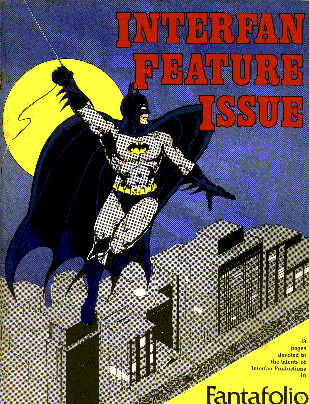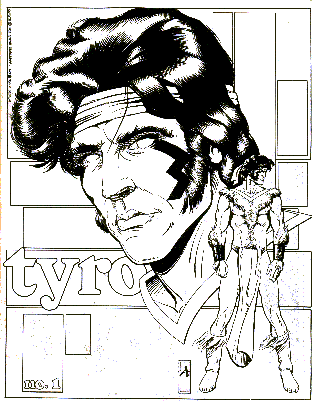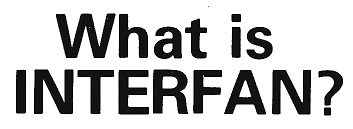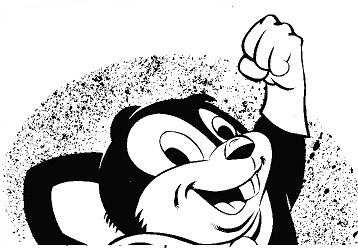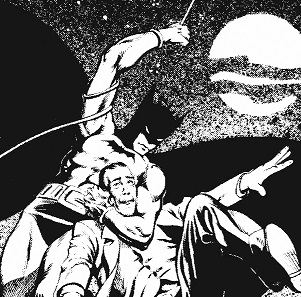
INTER-FAN BEGINNINGS
INTER-FAN was started in the 70's by dedicated fans, (most notably Steve Clement) who had no outlet to get their talent noticed, so he and other concerned fans decided to take things into their own hands and make opportunities where there were none. To them I dedicate this site.
Toward the bottom of the page are three covers to magazines that tried to enlightem the public to the wonderful possiblities and opportunities INTERFAN (as it was known then) had to offer and talents of future superstars. The cover on the far right is one of our endeavors into self-publishing,if we knew then what we know now it could have been better but the experience was priceless! This was in the early eighties and on a shoe-string budget, but I would like to thank Jerry Ordway for spending his valuable time to ink the cover. The characters by the way were Fan-man created by Jim Bertges and Chris Ecker (thanks you guys!) and Key-guy I did and was based on a comic shop owner I knew in Thousand Oaks California (the city that Kirby lived), who thought the fanzine was a great idea! Beyond the articles below are other publications that tried to enlighten the masses of that which is INTER-FAN.
From time to time I would like to talk about the history of INTER-FAN and mostly from the ones who were there. Before we start I thought I'd start with Jerry Ordway who took time out of his busy schedule to write down some of his memories. Hope you all enjoy!
Hey Doc, I became involved with Interfan after Steve Clement saw my work in Tim Corrigan's Superhero Comics, a fanzine circa 1974 or so. I dealt with Steve mostly through the mails, lettering a few stories, and drawing some proposed covers for Alan Light's Comic Buyers Guide, which never saw print.
Mike Machlan, a nearby friend and artist who I put in touch with Steve, dealt mostly via phone, and drew a fair amount of what I remember to be great stuff-- a few CBG covers, and a few stories. Mike and I flew to Rhode Island from Wisconsin in the summer of 1976, to stay at Steve's place, and work on Interfan stuff.
We met REM Clements, a writer, as well as Dave Mazzuchelli, a young fan artist. The following year, Mike and I drove to R.I, picking up Peter Iro in Buffalo. During our stay that year, we drove into New York City to visit DC and Marvel, in search of work. Mike Machlan almost landed the All Star Comics pencilling gig, which eventually went to Keith Giffen.
Anyhow, we all went home empty handed, but with the memories of a great trip with us. After that, I did less and less with Interfan, as a result of working full time in the graphic arts field, and eventually lost touch with Steve Clement. Steve tried to do some interesting things, and was a writer ahead of his time in many ways, tackling themes which were later explored by writers like Alan Moore, and others in the 80's.
I regard my time spent with Interfan as very valuable today. I met many great people, and felt like I belonged to something, in a time when few fans were united in much of anything. Best, Jerry O
If you want to see more of Jerry's pro work go to
The following is courtesy of Matt Bucher's Utrazine! These are the recollections of previous IF guru Jim Bertges! As it appeared in 2000! If you want to see more of Ultrazine and their organization go to
I became a hardcore, card-carrying comics fan in the summer of 1963. I was twelve years old (which as we all know is the Golden Age of comics), and my mom brought me home a copy of the Strange Tales Annual #2 with her shopping. Looking back on it now, the story, which featured Spiderman and the Human Torch chasing down a pretty lame villain called The Fox, was rather innocuous. However, there was something there that grabbed me. I had read comics before that -- Donald Duck, Superman, Batman -- but something in that Marvel comic turned me into a fan. From that point on, I bought nearly every Marvel and DC comic I could lay my hands on. Heck, I even picked up a few Gold Key comics that looked interesting.
Eventually I narrowed my focus to just Marvel and I even joined the Merry Marvel Marching Society, my first attempt at organized fandom. I put up a box with a M.M.M.S. sticker on it at the newsstand where I bought my comics. I provided a pencil and slips of paper for other interested Marvel fans to fill out their names and addresses so we could get together and discuss comics. No one responded and I went through Junior High and High School with only a couple of friends who also read and collected comics. It wasn't until 1969, a year after I graduated High School, that I realized there was such a thing as organized fandom.
That year my High School Creative Writing teacher invited Ray Bradbury to speak at the school. Since I was one of her favorites and she knew I was a big Science Fiction fan, she invited me back to hear him. Afterward, I was lucky enough to meet Mr. Bradbury personally back stage. He asked my friend Michael and me if we were going to the big convention in San Diego that summer. We answered with blank stares and he explained that there was a comic book convention organized in San Diego and gave us the information to contact the Con. At the time it was called the Golden State Comic Convention, but it eventually evolved into the San Diego Comic Con and now Comic Con International, one of the largest if not the largest comics conventions in the world. That very first San Diego Con was my very first brush with organized fandom. I liked it.
I was a regular attendee at the Con through its early years and that's where I encountered my first fanzines. These were very slick, offset-printed affairs, some even featuring color. There were titles like Witzend, Alter Ego, Rocket's Blast Comics Collector (RBCC), Squa Tront, Promethean Enterprises and Spa Fon. Many of them were produced by comics professionals who sought an outlet for work they could not do in mainstream comics. Others were fan-produced tributes to Golden Age and EC comics. Still others were showcases for artists who had honed their talents in the Underground Comix scene. However, the one fan-produced publication that made me feel like I was in touch with other folks who felt as I did about comics was the tabloid newspaper style, The Buyer's Guide for Comics Fandom (TBG). Alan Light provided comics fans nationwide a way to buy comics, sell comics, advertise, learn, and inform themselves about what was happening in the world of comics. He also provided the means for smaller fanzine publishers to expose their product to a wide and enthusiastic audience.
In 1973, I moved from inexpensive San Bernardino, CA, to very expensive Los Angeles. I wanted to study filmmaking and LA was the place to do it. I had a job that paid $115 a week and I foolishly took an apartment that was a bit beyond my means. The place cost an exorbitant $150 a month, but it looked so cool that I had to live there. The combination of living expenses and school expenses forced me into slowly selling off bits of my comics collection. However, I hung on to the fanzines I had acquired, both professional and amateur, because they held greater meaning to me than the comics they celebrated.
I still had an interest in comics and comics-related subjects, I had only lost interest in re-reading all my old comics over and over. I needed the space and most of all I needed the money. In 1974, I married the lovely Rhona Kurland who encouraged my love of fantasy, science fiction and comics and still does to this very day. She encouraged me to write and helped keep my creative fires burning. A year later, I spotted an ad in The Buyers Guide that would plunge me headlong into the world of fanzines. It may not have changed my life forever, but it sure gave me some very enjoyable years. The ad was a full page in TBG and featured what looked like a cowboy wearing a bandana across his face, like the bank robbers of old. It was a call for writers and artists to join a new group being formed called InterFan.
That was for me. I sent off a letter to Steve Clement in Rhode Island and signed on as a writer. InterFan held out the promise to get the works of its members published in a wide variety of fanzines across the country. Steve had some contacts with comics professionals and they would review some of the material. It seemed like a way to be creative, get some exposure and maybe�just maybe get into the pros. I deluged Steve with story ideas, most of which he liked and I turned into comics scripts. I also corresponded regularly with Steve and tried to provide new ideas for running InterFan and encouraging the members. Steve had the title of Editor of InterFan (which was only proper since he had founded the group and could have any title he wanted). He had two Assistant Editors who helped him coordinate the nearly two hundred members efforts: Robert Clements (no relation) and Sam Maronie. In those early years, I had little contact with any of the other members besides Steve, Sam, and Robert. Eventually Sam left the group to become a professional writer (you've seen his byline in Starlog and Fangoria), Robert dropped out due to personal problems, and Steve asked me to become an Assistant Editor.
I began by coordinating writers and artists and looking over scripts. I was still writing my own stuff and waiting to see something in print. My first story, Incident At the End of the World, was printed in Fandom Circus. It was illustrated by Bill Neville and it's nearly impossible to describe the feeling of seeing my own words transformed into panels and pictures and there on a printed page. It's quite a rush. Late one evening, I got a phone call from Steve, he had decided to pursue his own writing career and asked if I would take over the running of InterFan. I was stunned, but accepted, and not long after I received the full mailing list and as much art and other materials as Steve had on hand. That's when my full involvement in fanzines really began.
It was 1977. Rhona and I had moved into a three bedroom house in Simi Valley, California (where we still live today). I set up my office and typewriter in one of the spare bedrooms and set to work. Through The Buyers Guide, I started contacting fanzine editors. I created flyers illustrating InterFan art and laying out the InterFan offer to those editors. InterFan would provide high-quality fan art and stories to any fanzine that wanted them, free. All we asked was for a copy of the fanzine for each artist, one for the InterFan archive and the prompt return of all original materials. On the other side of the coin, when fan artists and writers heard about InterFan, they wanted to know how to join up. As long as I ran the group, anyone was welcome to join. We asked for a $1.00 lifetime membership fee (it helped me buy stamps, there was a lot of mailing to do) and that was it. Members came and went, but there was always a core of truly talented people who made InterFan work.
The one truly sad note to my whole InterFan experience was contained in a letter I received from Robert Clements. He wrote to tell me that Steve Clement, InterFan's founder, had died. However, there were few details. I called the phone number I had for Steve and spoke with his mother. I asked if Steve had been sick and what had happened. She told me he wasn't sick, she said, "He just came home from work one day, went to his room and shot himself."
I could only tell her how sorry I was. I'll probably never know what made Steve feel he had so little to live for, but I did want to make InterFan work, if not for my own reasons, then for his memory. It's just a shame that he didn't live to see what a success his idea became and how many people it really touched.
Since I had no professional comics contacts to help evaluate the work of InterFan artists, I called upon one of InterFan's most talented and prolific artists, Sam De La Rosa, to be our Art Director. As I said, it was InterFan's solid core of talents that kept the group going. I counted each and every one of those guys as my friend and still think of them. The names that come easily to mind are Reuben Pharms, Don Secrease, Paul Daly, Harv Chin, Bud Perkins, Bill Neville, Willie Blyberg, Pete Iro, Carl Taylor, Doug Herring, Larry Houston, Mike Romsberg, Mark Lamport, Chris Ecker, Gary Ostanski, Rick Burchett, Mike Machlan, Ed Savage, Neil Riehle, Jerry Foley, John Beatty, and Karl Kesel. There are others as well, but that will require some research. It was these talented folks and others who came before and after them that made InterFan a fan success for ten years.
Some of the earlier members of InterFan went on to fame and fortune while InterFan was still plugging away and they became a calling card of sorts for the group. When we said that people like Dave Sim and Jerry Ordway were once members, it automatically elevated the level of the organization. However, that could have an adverse effect as well, when people misunderstood and thought it was an organization of professionals. We did run into some controversies along the way when fanzine readers complained that these high-falutin' InterFan artists were crowding out the real "fan" artists from the pages of fanzines. What they didn't realize was that InterFan artists were all fans and amateurs, but we didn't send out any art until it was the best we could make it. One of the goals of InterFan was to give young fan artists a bit of education. Sam De La Rosa was an accomplished artist and provided useful information and tips for all our artists. We wanted all these young guys who were submitting their art on pieces of notebook paper, drawn in ball point pen, to understand that if they wanted to become comics professionals, they had to work like professionals. We let them know what materials to use and how to use them. We encouraged everyone to do his best and everyone got his shot at publication. But we only sent out the best of their work. It was our attention to quality that gave InterFan artists their reputation in fandom.
Even with all those talented members and their enthusiasm, InterFan would have gone nowhere and been completely unknown without the fan publishers. It was those guys and gals who put their time, effort, sweat, and money into creating their own amateur publications that made InterFan both necessary and possible. Whether a publisher was just starting out a 'zine or already had several issues under his belt, there was always a need to fill some spot, somewhere. Usually, an editor would send us an introductory letter and say, "Please send me some art."
Eventually, however, our relationships developed with the fan publishers to a point where they could make specific requests and ask for material from specific artists. We would start out providing spot illustrations to plug into a blank spot and progress to providing covers, strips, story illustrations and illustrated prose pieces as well. It was a dizzying time and my mailbox was always crammed with letters from publishers, packages of art, complimentary copies of zines and cries for help from others.
Here's a pretty typical initial letter I received from a fan publisher:
Jim:
Hello, my name is Matt Bucher and I publish a fanzine entitled, Ultrazine. Well, I read AFTA #2 and heard that you supply zines with art. I was wondering if you could do a couple of illos (5 � X 8 �) and perhaps a cover for #8 or #9. I would greatly appreciate this more that I can tell you. Enclosed is a sample ish. Please don't be discouraged by the book, as I know you must be used to books such as The Comic's Journal, etc. Now, if you could contrib, maybe Ultrazine will grow and soon be listed among TBG, TCJ and TCR. Thank you very much,
Matt Bucher
From that point we developed quite a relationship with Matt and Ultrazine which has ultimately resulted in the words you are reading here. However, Ultrazine wasn't the only publication InterFan was involved with. Sometimes I think that nearly every publication with the terms "Comics" or "Zine" it the title either featured InterFan art or were badgered by us to use some. And there were plenty of other zines with neither of those words mentioned that used our stuff as well. It was those guys that gave InterFan a reason to exist.
We became involved in Bill Dale Marcinko's infamous AFTA, contributing a huge amount of art and written material to his second issue. I even became a kind of agent for Bill and AFTA, writing letters to big shot distributors and comic shop owners like Bud Plant and the late Phil Seuling and touting the merits of AFTA and why they should support and distribute it. Then something worked, because the third issue was found all over the country. Bill was an inventive guy with a quirky sense of humor that often led me to question his sanity. He had a way of using very serious but fictitious events like death and muggings for self-promotion. The very name of his publication, AFTA, is an acronym for Ascension From The Ashes, which refers to the fact that Bill himself had fictionally died and was back with a new fanzine. It was a fun and interesting ride that lasted only three issues and was gone as quickly as it had appeared.
InterFan had connections with zines that lasted longer than three issues, too. Gary Groth of The Comics Journal was very kind to InterFan artists. He knew Steve Clement and regularly used illustrations from InterFan in various parts of the Journal. He even kept us informed when his company, Fantagraphics, was planning to expand its publishing line into comics. He invited us to submit ideas and scripts for consideration. It was a relationship we valued and that made InterFan more visible to fan publishers.
Around 1978, we created a comic strip called FanMan. It was a three to four panel, newspaper-style gag-strip that starred our muscle-bound, but none too bright superhero, FanMan. The idea was to get as many members involved in the project as possible and everyone was invited to submit ideas. Chris Ecker was given the task of designing our bumbling super guy and gave us a likable hero we could laugh at. With the first couple strips done and more in the works, I contacted Alan Light, who published The Comics Buyer's Guide. Alan was kind enough to publish all our FanMan strips in TBG on his TBG Funnies page. Once again, it was high-level exposure that gave credibility and status to InterFan and its members.
The greatest bulk of the work we did was published by small fanzines, many of which only lasted two or three issues. Some of those zines were even published by InterFan members. As with anything, the quality of the publications varied greatly. Some were only several photocopied pages stapled together while others were offset with wrap-around covers. It all depended upon how much money a publisher had to put into his labor of love. InterFan was dedicated to support all of them, no matter how large or small. Our guys wanted their material published and the zines needed the art -- how could we go wrong? Here's a small sampling of some of the pubs where InterFan played a part: Alpha Touch, Radion, Copper Toadstool, Entropy Comix, Fandom Circus, The Fan's Zine, Fantasia, Great Krypton, Inertia, Lollapaloosa, Night Voyages, No Sex, Plastizine, Thrust, Superzine, Viper Visions, Ultrazine, Whizzard, and Wowiekazowie!. There were many, many more that came and went, allowing the artists and writers of InterFan to be a part of their dream.
Mostly it was a great ride. Sure we had some difficulties. You don't do something for ten years and not run into problems. There were artists who were so protective of their art that they thought that everyone was stealing it. There were publishers who hung on to InterFan material for what seemed like interminable periods of time. We didn't have many personality conflicts or arguments among our members, however. That's mainly because we never actually saw each other. Most of our communication was via the mail and sometimes over the phone. As I think about it now, I can remember meeting only one InterFan stalwart in person at a San Diego Comic Con: Sam De La Rosa.
Sam was the backbone of InterFan. He knew all the artists and their capabilities. He fielded artwork, assigned inkers to pencillers, helped in getting art to zines and then back to the proper artists. It would have been impossible to keep InterFan running without Sam's help. Still, I only met Sam face to face one time. We spoke on the phone often and corresponded as though it was our job to keep the post office in business. Of course, I've lost touch with Sam over the years, but I still remember him fondly and owe him thanks for his untiring work on behalf of InterFan.
The only major disappointment I can recall in my time with InterFan was the time we were working with a couple of guys who offered us our own publication. Who they were doesn't matter now, but those of us at InterFan were very excited about the possibility of a professionally published showcase for our work. We worked together for months submitting, tweaking, writing, trying to do just what was requested of us -- but in the end the whole thing fell apart. I could feel the anger and disappointment from all the members I corresponded with, but we kept on with our submissions for other fanzines around the country. Later, that dream was revived and actually came true.
The InterFan showcase became a reality as the third issue of a beautifully printed magazine called FantaFolio, which was published and edited by Peppy White. Peppy contacted us and helped us put together a project that was cover-to-cover InterFan. It was a far more collaborative effort then our previous experience. We brainstormed with Peppy as to what the contents should be. We gave him some of our best strips, created portfolios of our most interesting artists, and developed a themed portfolio to illustrate the pretentious, but interesting idea of "God Creating a Superhero." The whole project was truly a dream come true and one of the great high points of my association with InterFan. It went together without a hint of ego and turned into a project of which everyone involved was rightfully proud.
Another proud moment came when InterFan became the subject of an article in the Starlog Group's Comics Scene magazine. Comics Scene was the precursor of what Wizard is today, a slick national magazine devoted to the comics industry. I lobbied the editor by sending InterFan material and a copy of FantaFolio #3, hoping there would be some interest in our fan organization. As it turns out, one of our former members, Sam Maronie, was writing for Starlog at the time and since his name appeared on our members roster, he was assigned with the article. With this national exposure, the flood of mail threatened to bury my mailbox, but most people who showed initial interest never followed up. However, we did gather a few new members and generated interest among budding fanzine editors around the country. The funny thing is that the article generated interest for years following its publication. Even after InterFan was no longer functioning, I was receiving letters from people interested in joining, because they had picked up that old issue of Comics Scene.
I even delved into a bit of publishing myself, on a very small scale. I had to have a way to communicate with all the InterFan members at once. I needed to tell them which fanzines were using InterFan material so the membership could support them. I wanted to welcome new members and get all the members to interact with each other. I developed a little newsletter. At first it was just a typed sheet that I sent out to our member list, but since I had access to all of our InterFan art, I began to include illustrations and stuff in the newsletter and gave it a name, Elmo. Why Elmo? I just liked the name, it sounded funny and at the time it wasn't as well known as it is now. After I named our official newsletter Elmo, I decided to follow the titles of the old Universal Frankenstein movie series. Subsequent newsletters were called Bride of Elmo, Son of Elmo, Ghost of Elmo and Elmo Meets the Wolf Man. Eventually, I had artists doing special cover art to illustrate the titles. Inside, I used as much art as I could. We even asked our members to submit self-portraits so everyone could get an idea of what we all looked like. Doing the Elmos gave me a small idea of what the fan publishers were going through in trying to get their zines out, except for the fact that I wasn't selling Elmo. Unfortunately, Elmo Meets the Wolf Man was the last one I produced. I really wanted to continue on through House of Elmo, House of FanMan, and even Abbot and Costello meet Elmo. After that I would have gone to the Hammer titles, Curse of Elmo, The Evil of Elmo, Elmo Must Be Destroyed and Elmo Created Woman. Alas, that never happened.
I eventually burned out and the demand for InterFan material grew to a trickle, so I signed off. A fellow named Lance Boucher wanted to take over the group so I gave him my member lists and wished him luck. After a few months, there was no longer any word from Lance and InterFan had officially faded away. In retrospect it's sad to think of the end, but it's pretty inspiring to think of all we accomplished over the ten years the group existed. I met a lot of great people, kept my creativity going, and made my own little contribution to comics fandom. However, that was not the end of my association with fanzines.
I had corresponded with Don and Maggie Thompson for years and had contributed material to their Beautiful Balloons column in The Buyers Guide. Krause Publications bought TBG from Alan Light, renamed The Comics Buyers Guide, and hired Don and Maggie as editors. CBG had a number of columns, among them a fanzine review. When their fanzine columnist left, Don and Maggie asked me if I would take over and I became The Zine Fan for CBG. Instead of providing materials for fanzines, I was reviewing them and trying to encourage the CBG readership to support fan publishing in all its aspects. The variety of materials I received for review was astounding. There were science fiction zines, mini comics, strip zines, fiction zines, mystery zines, pulp zines, you name it. It was great fun using the knowledge I had gained from InterFan to help those publishers gain a wider audience.
Now, nearly fifteen years later, it's fun to dig through the boxes of old zines and flip through the old InterFan letters. I'm quite a pack-rat, like most collectors, and I find it difficult to throw away something that holds so much meaning. I have two binders with hundreds of pieces of correspondence from InterFan members. I found two boxes of fanzines in the garage and looked them over, rekindling old and pleasant memories. Sometimes I think how great it would have been to have today's technology back then, how different it would have been with desktop publishing and e-mail. That's just the point, though -- it wouldn't have been the same. We really accomplished something back then, we comics fans. We had a common love that we had to say something about. We poured our time and money and hearts into our efforts and we came out of it all with a sense of accomplishment that has lasted through the years. It was a great time.
Note: This was written to the best of my memory. If anyone has any corrections or additions, I welcome them. I know I can't get everything right. And, if you're an InterFan member named Kent Featherly who used to sign his art "Cockroach", get in touch with me, I finally found that strip you wanted back.
Note from Matt Bucher: I personally owe Jim Bertges a great debt of gratitude for his assistance with Ultrazine - not to mention for his terrific friendship. Especially during Ultrazine's early days, the InterFan artwork that I used helped elevate the book's quality tremendously. For example, the cover to Ultrazine #9 - provided by InterFan - was flat-out XLNT. Thanks, Jim!/
INTER-FAN BEGINNINGS Part Two
The above comments I believe were done in 2000 and it is now 2005 and I haven't had much to say here but a funny thing happened as on The Ultrazine site I was replying to a post to hlpe Sam De La Rose try to find copies of fanzines he had lost in a fire. Jim Berges and I then started talking about IF whne Jim asked if I wanted his IF documents, which included letters, copies of art, and scripts he had kept all these years and of corse I said "Yes".
I have as of today September 25, 2005 received 7 packages of great memorabilia of IF's past including my original letter to Jim to join IF. I have gone through a lot of the items and will still be receiving one or two more packages. It's funny how I took over back in '85 and did some things though not to the extent I wanted and did put out one zine with the help of Joel West and Gene Phillips and Anthony Gagliardo. This zine had art from the likes of Laurie May and Lyle Nisenholz and some older members whose art I had aquired from Jim.
Then in 1999 after a some what long hiatis I discovered the Inter-net and thought what a great way to bring back IF, which I did using a Tripod program which unfortunately that version of the site is gone. So here we are. Below are some of the things that I thought might be interesting and there will be more. In fact we are planning an IF Anthology book to celebrate 30 years of helping creators.
INTER-FAN BEGINNINGS Part Three
Recently I received correspondence from Authur Moore who had joined our IF Forum, I asked who he was and such. He e-mailed me back stating that Jim McPherson had given him the link. Authur was an early member and would be writing me his experiences with IF. Jim was around at the birth of IF so I wrote him too and he replied below. I hope Jim will join the Forum as well and make himself known to the other members. The links mentioned below you will have to cut and paste till I put the right scripting in to make them work.
Hi Jim,
I've given your e-mail to Arthur Moore . He might want a Fantafolio.
He bought some of Steve Clement's Inter-fan art way back when. I've been looking at the Inter-fan site, and the Ultrazine group messages. I'm going to send this scan from a photo to Sam De La Rosa. It's something he inked and colored for Inter-Fan. Arthur may have it so I may try to buy it. (I pencilled it)
I did some Inter-fan work at the very beginning. I was in High School and wasn't good at finishing work unfortunately. I knew Steve Clement since I was about 12 years old. He really was a good guy and I've always felt bad about what happened to him. I was reminded of him because I just saw the drawing Jack Kirby did for him at the San Diego con.
http://www.tri-stateoriginalart.com/pages/gallery4.html
Very sad that the art I used to look at framed on his wall is still here and not Steve himself.
I was there when Jerry Ordway and Mike Machlan came to visit. Steve connented them with Joe Sinnott to do some backgrounds for Fantastic Four. That's all I can think of right now,
Thanks, Jim McPherson
I met Steve Clement though a comic book letters page some time around 1971. He worked as a security guard, but he said that was great because he could stay up all night writing and would soon be a professional comic book writer. I think he was 21. He lived with his mother in Pawtucket, R.I. Soon he moved into his own apartment. Steve was an Extrovert and encouraged people constantly. He sold me some comics at a wild discount; I never had much cash; and asked me to organize his comic collection which was in huge heaps in the basement. I got to look though the comics with included the Harvey Spirits, and I think he has a small safe upstairs with included some golden age comics like Airboy which I had seen in the Steranko History.
Steve had gone around to drug stores and bought 100 isuues of Conan #1 and New Gods #1. (Years later, I remember him selling the Conans in the Comics Buyer's Guide to raise money to publish. I don't think it happened.)
In the early days Steve worked with an artist named Rick Roe. I think I saw some information in the last ten years or so about him being involved selling old comics. He also did work for Will Murray's Duende pulp fanzine.
Steve asked me to go to a play he wrote, I think, called "Games." I think it was 1974. It featured a Joker-like character (called the Gamesmaster) with a multi colored outfit who narrated and who was supposed to be invisible to the other actors. I think the show consisted of short pieces on conflicted relationships. Maybe the Gamesmaster whispered in the actors ears, and unfortunately, forshadowing the future I think he even put prop guns in the character's hands. The Gamesmaster came out into the audience and directed a bunch of his lines to audience members including my mother, which made a big impression on her. I don't think too many people in Rhode Island wrote and produced their own plays. Steve always did things in a big way.
I think Steve attended the Rutland Halloween parade one year, and talked about seeing Don McGregor at a party. I think he dressed as the Flash and he talked to me about how he made the ear pieces out of plastic martini glasses with the ends melted into wings, but I never saw it.
Steve took trips to New York looking for writing work. I remember he talked to Larry Lieber at Atlas. He described the story where Jim Warren said "Do you think you're good enough to work for me?" if the artist said yes, he would pull a rubber stamp out of a drawer and stamp the artwork in red,"Bullshit."
I know Steve sold at least one story to Warren for Creepy. He told me one day that I had to write a letter of comment to the magazine about it and if it was decent Gerry Boudreau (local Warren writer) would print it. The letter did indeed end up in the issue with the football player with the skull face.
At some point I think Steve decided he needed to do a lot more fanzine work in order to become a successful comic book writer. So in his way he decided to reorganize fandom to make that happen. I believe Rick Roe made the Inter-fan stamp. He contacted a bunch of people with work in fanzines and asked them to join. I remember inking a Karl Kesel drawing with the Shadow, I pencilled a drawing of Spider-Man and Howard the Duck in a Ditko landscape which was inked by Dean Motter. A cover by Mike Machlan, inked by me, a very inexperienced high school kid, appeared on The Comics Buyers Guide Issue #126. Steve took a lot of chances with teaming artists up and I think people were sometimes not happy with the results. I remember Tom Linehan and D.L. (Deal) Whitley being involved at this time. I think I heard D.L. passed away. David Mazzucchelli did some short stories, I don't know where they ended up printed.
Jerry Ordway and Mike Machlan drove out from Wisconsin(?.) David Mazzucchelli and I went out to meet them. I saw Jerry's fanzine Okay Comics. I think he put our names in the 3rd issue.
The Weird cover I sent was a result of a trip Steve took to New York. He would return and make phone calls to many of the Inter-fan group members about what had happened. I remember he explained that the editor there was editor because he had a gun! Imagine my surprise when I found this website corroborating Steve's story.
www.badmags.com/bmmyronfasshtml
Steve said he needed artwork for Weird magazine, right away, and he wanted to completely redesign the magazine. (Check the website to see what the magazine actually looked like.) This, of course, was not appreciated by the gun guy. I think at this point Steve developed a payment system for the artists which included a percentage set aside for taxes. This led to my first professional sale to UFO magazine for inks for an interior illustration ($17.50.)
Jack Kirby appeared at the monthly Boston comic convention. Steve bought a pencil drawing from him. I recall Steve telling me at this time that he had been investigating and knew who was behind the big DC art theft. Nothing ever came of this.
At some point Steve said one of the benefits of Inter-fan was going to be that comic professionals would critique the work. Therefore I received a letter from Jim Shooter about my inking I think on a Jerry Ordway Fu Manchu/ Shang Chi piece. I think other people got critiques from Joe Sinnott.
Steve was involved in some local convention (R.I.) I vaguely remember. He was a writer guest, I think with Gerry Boudreau, and Gene Colan came to the show and drew sketches. I got to watch him draw for a long time. Steve dressed up in a spandex Dr. Strange costume at the end of the show.
Steve started a multi-chapter superhero story through Inter-fan which was never finished. I did a chapter, and a pinup which is all I think survives, printed in the Fantafolio. My chapter was a wreck. I made the pages out of smaller pieces of paper from an artist's pad which annoyed everyone involved. Each chapter was in a different style. My chapter had a girl in a white outfit and a raygun, who fought a guy also with a raygun that could animate garbage. I got to design the villian and the garbage monsters. I think I was a senior in High School at the time.
I was in collage when I heard about Steve's death, months late. I worked all evening and weekends on class assignments and brought them in for criticism during the week. You know how if you're not doing artwork for a job with a deadline, it can always be better? It was pretty tough adjustment for me, of course at that time comics weren't considered art at my collage. I lost touch with most of my fanzine friends.
I never saw Steve unhappy. He seemed to be an optimist to me. It's really a lesson to everyone. If he'd been able to hang on, so many of the people he helped became professional artists. I'm sure they would have helped him.
PS. Most of the art I mentioned here I don't have copies of . I have some other fanzine stuff of Steve's. The easiest thing for me might be for me to xerox it and mail it to you. If you have fanzines like the Afta with drawings by me I'd love scans or xeroxes.
Recently in pursuit of fanzines, I bought the below pictured fanzine on eBay, much to my surprise ther were multiple references to INTER-FAN, (see inside credits I scanned), so I wrote Jim as his story was the first one in the book. Here is what he had to say.
By that time Steve had placed InterFan stuff all over. I'm not sure how much and where. This was certainly a large concentration of InterFan material and it was early in my tenure as Editor, but I don't think it was the first. I'm sure Steve and Robert had just as much stuff in other publications before I took over. Unpublished was very good to us and we had material in all three issues. If I'm not mistaken that issue contained my story "Incident at the End of the World" which would be considered blasphemous by many even today. That particular story really made the rounds and I think was published three times including this one.
| Various Early IF Projects | 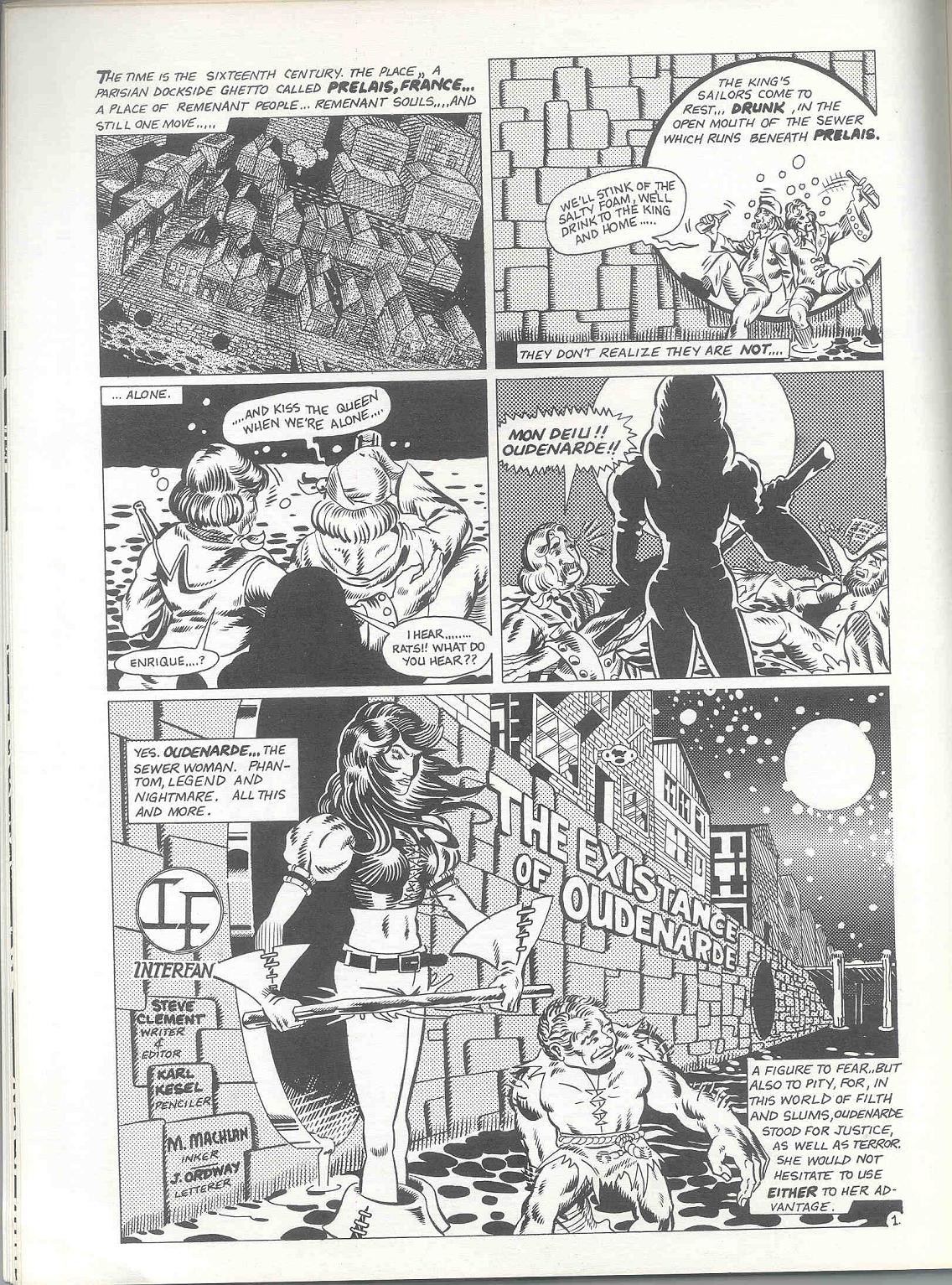
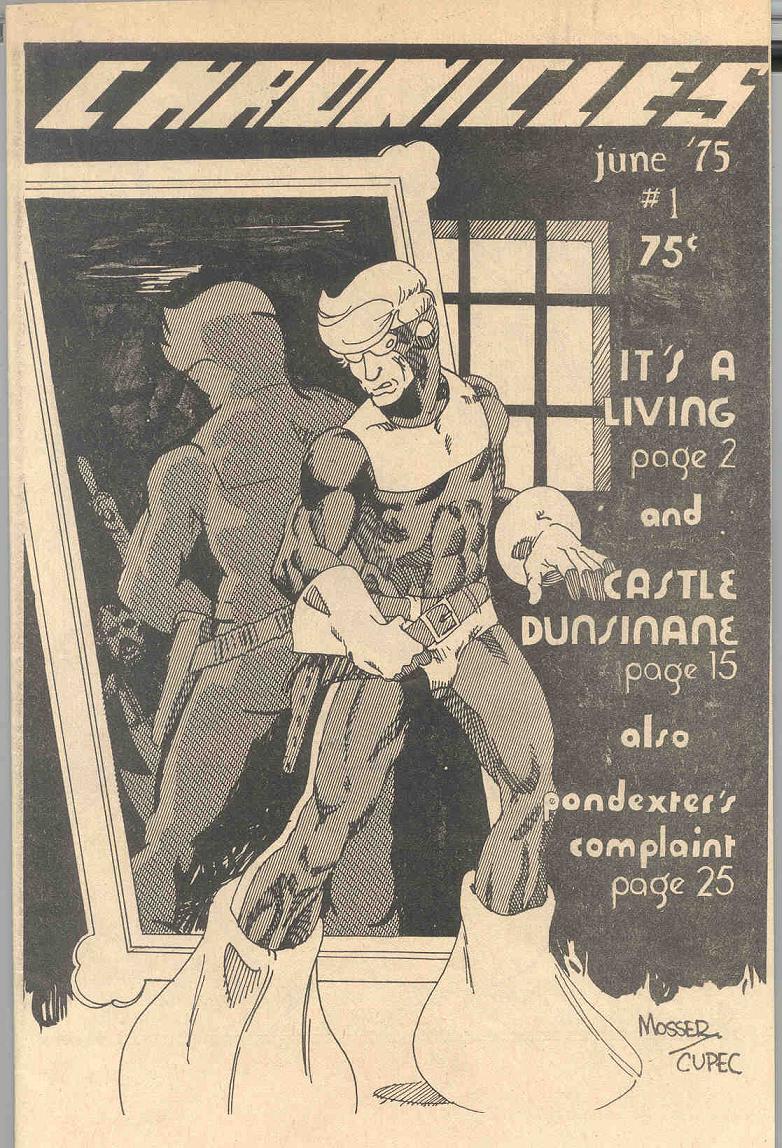
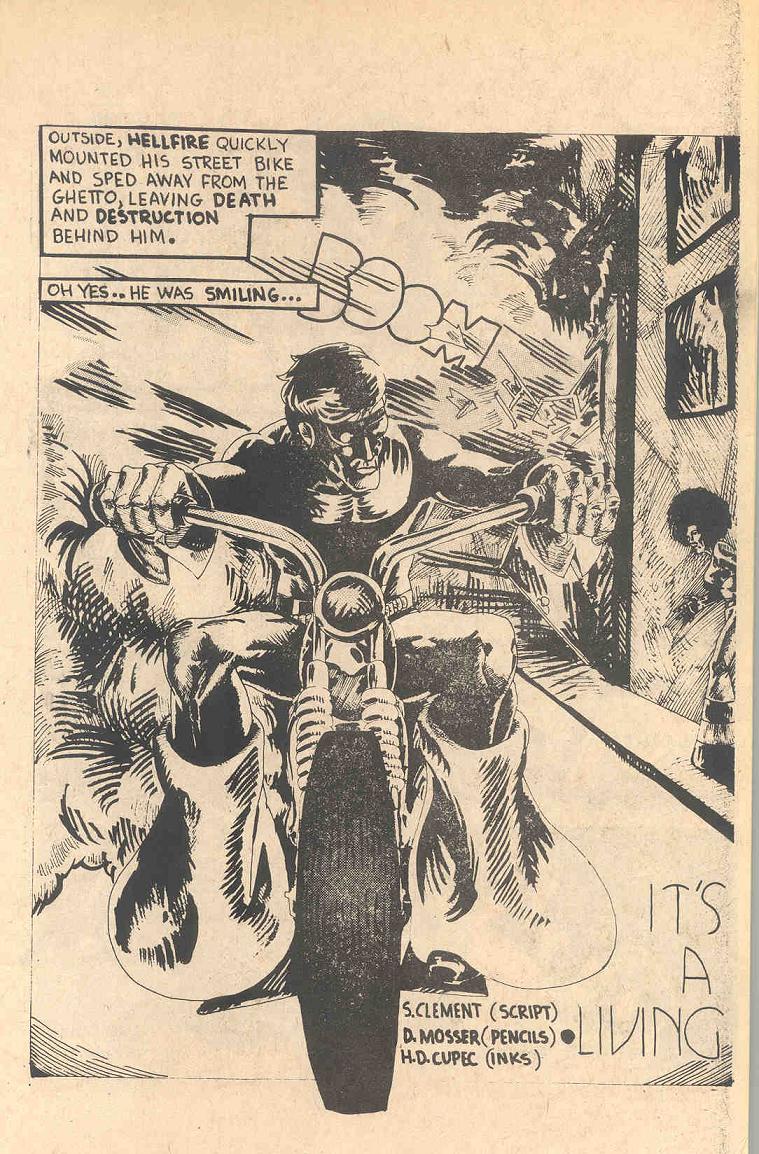
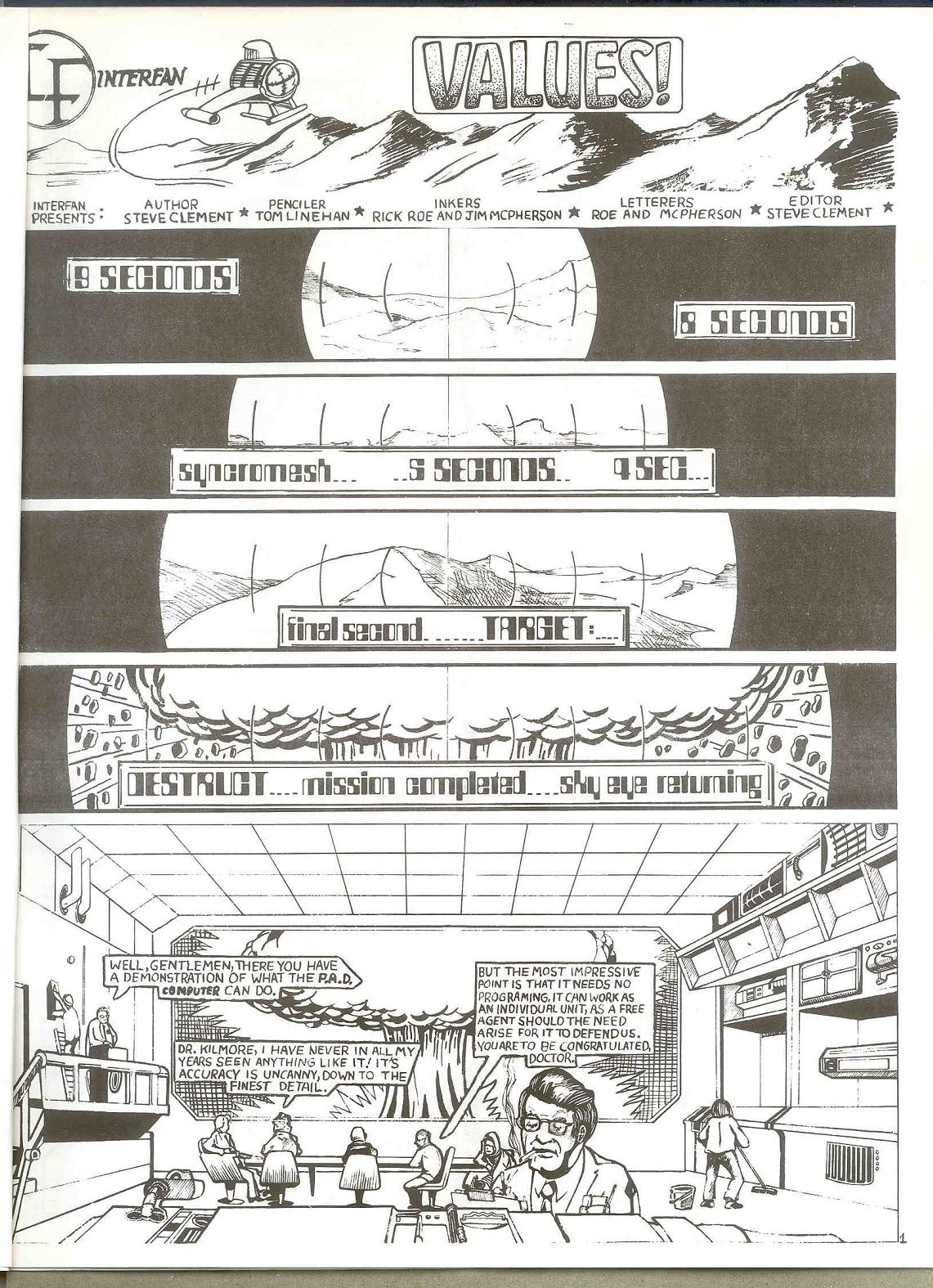
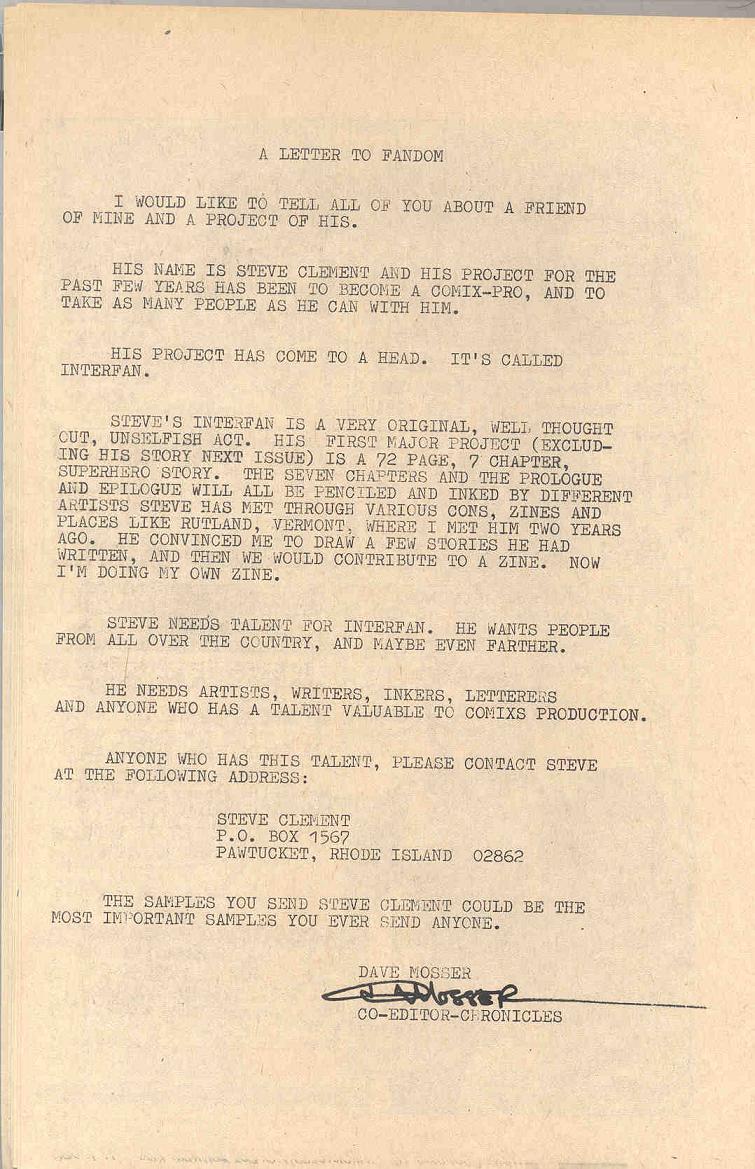
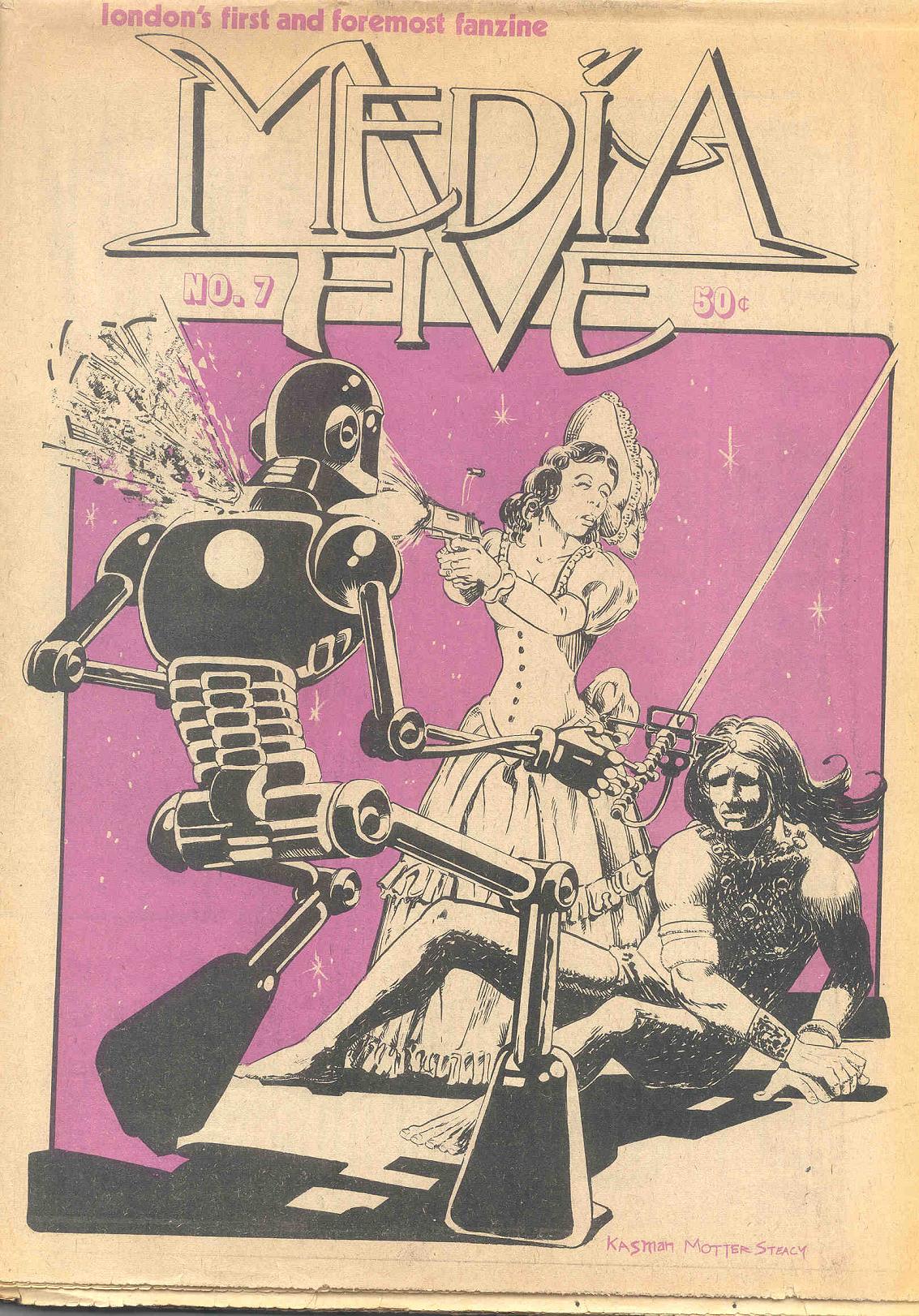
| |
| The Complete Guide to Convention Fandom by Steve Clement | |
| |
